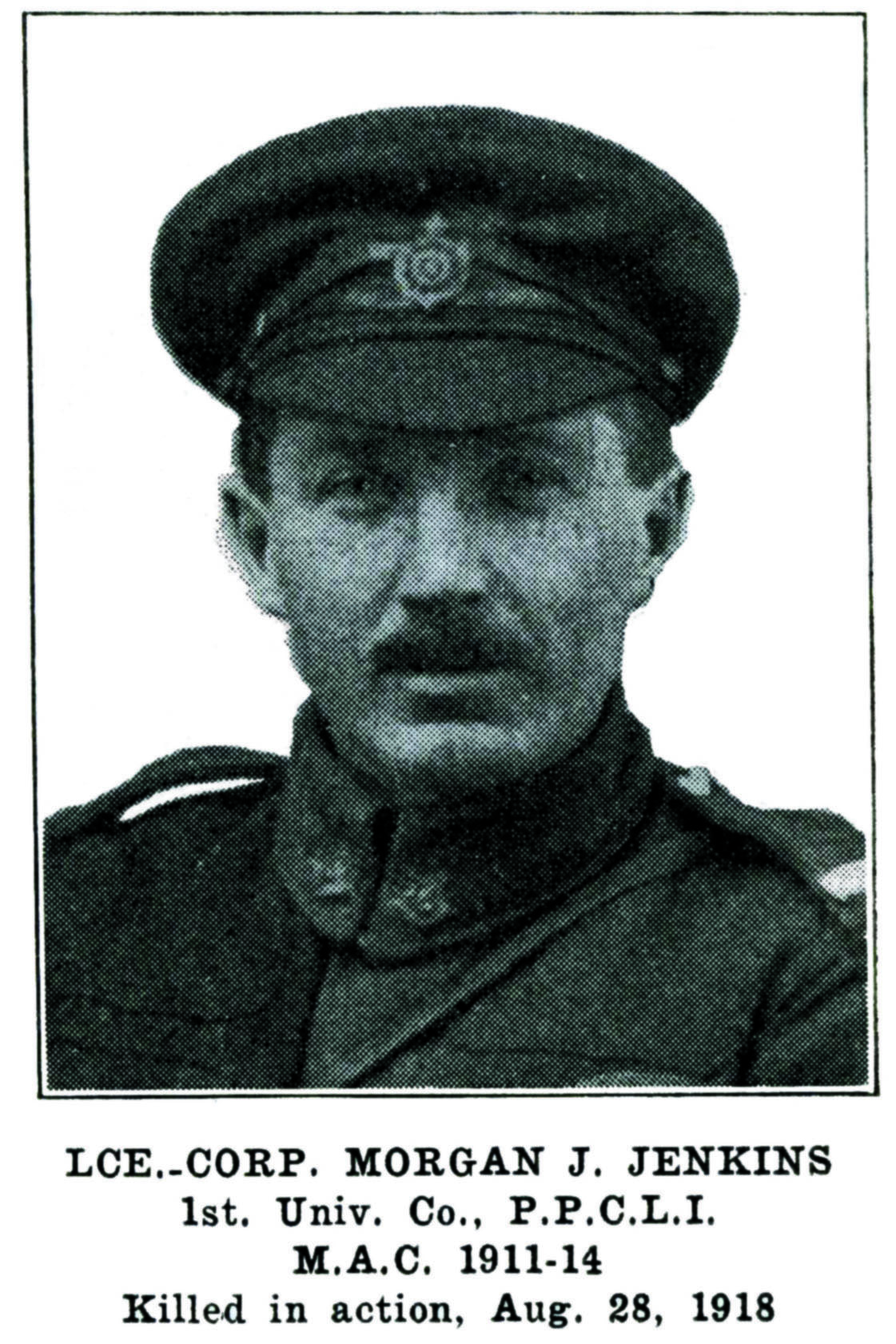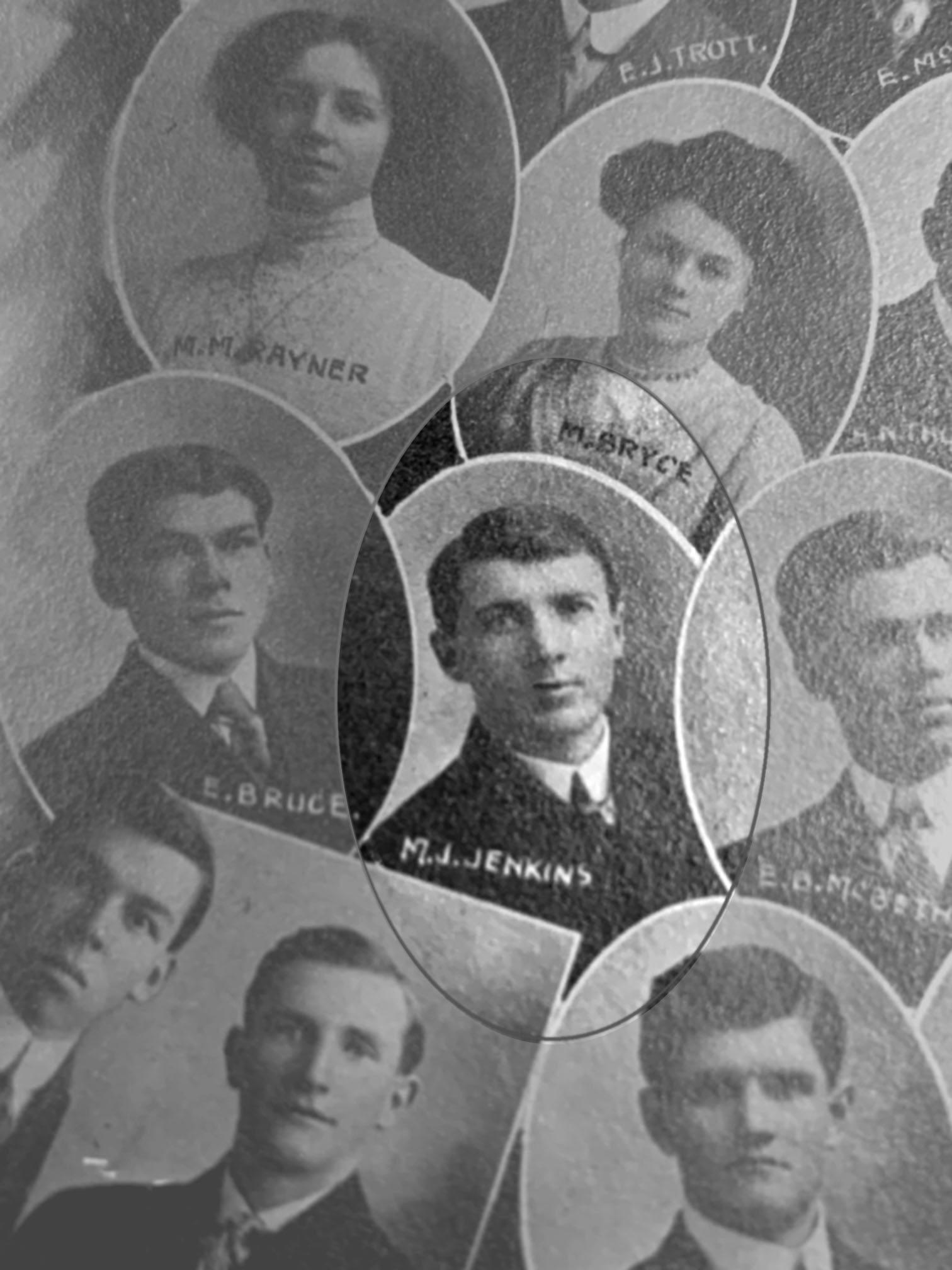Lance Corporal Morgan Jones Jenkins
In May 2019, a research report was received suggesting that an unknown grave at the Vis-en-Artois British Cemetery, Haucourt, in France, could be identified. The Canadian Armed Forces have confirmed that the gravesite in question is that of Lance Corporal Morgan Jones Jenkins.
- Born 14 May 1886 in Pontypridd, Wales
- Died 28 August 1918, at the age of 32
- Died serving with the Princess Patricia's Canadian Light Infantry, CEF
- Commemorated at the Canadian National Vimy Memorial
- Buried at the Vis-en-Artois British Cemetery, Haucourt managed by the Commonwealth War Graves Commission: Plot 5 Row A, Grave 12
Morgan Jones Jenkins was born on 14 May 1886 in Pontypridd, Wales. He was the son of Reverend John Jenkins and Elizabeth Florence Jenkins (née Capenhurst) who also lost two others during the First World War: Sergeant David Jones Capenhurst Jenkins serving with the 5th Battalion, Canadian Expeditionary Force (CEF) and Second Lieutenant Richard Jenkins serving with the Manchester Regiment (a British unit).
Before immigrating to Canada, Jenkins took courses with the Officer Training Corps in England. He studied at the Manitoba Agricultural College before enrolling on 8 July 1915 in Saskatoon, Saskatchewan. After enrolling, he joined the 3rd University Company of the CEF, based out of McGill University. The company left the Port of Montréal on 4 September 1915 aboard the S.S. Missanibie and arrived in England 10 days later. Private Jenkins was then posted to the 11th Reserve Battalion before being transferred to the Princess Patricia’s Canadian Light Infantry (PPCLI), CEF, which he joined in France in January 1916. On 21 August 1916, shortly after recovering from a bullet wound to his right leg, he was promoted to lance corporal. Lance Corporal Jenkins also served in the Canadian Corps’ intelligence service starting in November 1916. The intelligence service was in charge of gathering and transmitting intelligence on enemy strategies and resources in addition to engaging in counter-espionage. In June 1918, Lance Corporal Jenkins rejoined the PPCLI.
At the end of August 1918, the Canadian Corps took part in the Second Battle of Arras and advanced toward the Drocourt-Quéant Line. A solid starting position had to be established before initiating its capture. Therefore the 3rd Canadian Division’s 7th, 8th and 9th infantry brigades were charged with capturing a portion of the Fresnes-Rouvroy Line, the last line of enemy defence before the Drocourt-Quéant Line. The PPCLI, part of the 7th Brigade, fought between 26 and 29 August 1918. The PPCLI’s progress was costly. In three days, the regiment suffered 197 casualties, including 56 deaths.
During the night of 26 to 27 August 1918, artillery fire pushed the Germans back to the French village of Pelves, which was quickly occupied by the 49th Canadian Infantry Battalion. On the morning of 28 August, the PPCLI received the order to take Jigsaw Wood (a position used by the enemy to defend the Fresnes-Rouvroy Line) with the assistance of the 42nd Battalion on their right and the 49th Battalion on their left, as well as the support of two companies of The Royal Canadian Regiment in the centre. Intense enemy machine gun and mortar fire on the PPCLI’s left flank made the advance arduous. Elsewhere, the regiment met lighter opposition. The new Canadian positions, however, were bombarded by the enemy in the afternoon. Lance Corporal Jenkins was seen for the last time when the PPCLI had just reached its final objective: the far end of Jigsaw Wood. Lance Corporal Jenkins was first declared missing on 28 August 1918 and declared killed in action on the same date.
After the battle, a number of Canadians fallen in combat were temporarily buried in the Pelves Canadian Cemetery, 1.6 km south of the village of the same name. Among them, an unknown lance corporal from the Princess Patricia’s Canadian Light Infantry; this partial identification was probably due to the rank and unit insignia on the uniform. All bodies in the Pelves Canadian Cemetery were later reburied in the Vis-en-Artois British Cemetery, Haucourt, located in the Pas-de-Calais region of France.
After the war, Lance Corporal Jenkins’s name was engraved on the Canadian National Vimy Memorial, erected in memory of the Canadian soldiers killed in France during the First World War and who have no known grave.
In May 2019, the Directorate of History and Heritage (DHH) received a report from the Commonwealth War Graves Commission detailing the potential identification of Grave 12, Row A, Plot 5 in the Vis-en-Artois British Cemetery, Haucourt. The Commonwealth War Graves Commission had received a report from independent researchers raising the possibility that this grave was that of Lance Corporal Morgan Jones Jenkins. Extensive research undertaken by both the Commonwealth War Graves Commission and the DHH concluded that this grave could only be that of Lance Corporal Jenkins. No other candidate matched the details of the partial identification. Historical research was conducted using numerous archival sources, including War Diaries, Service Records, Casualty Registers, and grave Exhumation and Concentration reports.
In November 2019, the Casualty Identification Program’s Review Board confirmed the identification of Lance Corporal Morgan Jones Jenkins of the Princess Patricia’s Canadian Light Infantry, CEF. The Casualty Identification Program’s Review Board is made up of members from the DHH, the Commonwealth War Graves Commission, the Canadian Forces Forensic Odontology Response Team, and the Canadian Museum of History.
A headstone rededication ceremony was held on 28 September 2022 at the Vis-en-Artois British Cemetery, Haucourt, managed by the Commonwealth War Graves Commission to unveil Corporal Jenkins’s headstone. Family members and representatives from the Canadian Armed Forces attended the rededication ceremony.
For more information on Lance Corporal Morgan Jones Jenkins, you can consult his personnel file record held by Library and Archives Canada.


